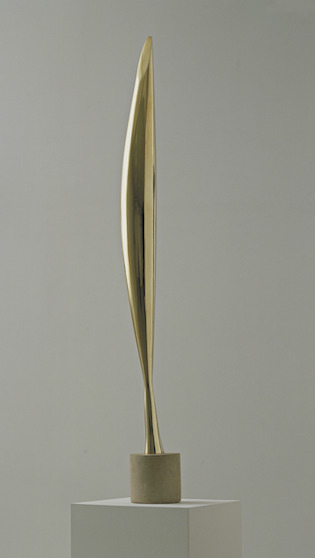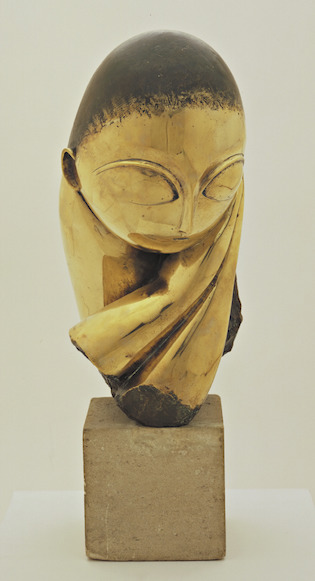Watching two people argue about art is like watching two people try to ice-skate uphill. It happens often at the New York Museum of Modern Art, where visitors can tend to bring friends whose interest in abstract art is weakened by seeing abstract art. The MOMA has reignited debates about aesthetics and art with its Constantin Brancusi Sculptures exhibit, which arranges 11 sculptures that have never before been exhibited together. Brancusi (1876-1957) knew his abstract sculptures and those of his friends—Marcel DuChamp was one of them—would not always be welcomed by critics, but he couldn't have known that his work would also lead the United States to reconsider what its law constituted as "art."
In 1926, Brancusi's sculpture Bird in Space arrived in the United States from Paris for an exhibition. Drama quickly ensued. The U.S. Customs Service had placed a tax on the sculpture, refusing to acknowledge it as a work of art. Because its title did not match its appearance, customs officials said, Bird in Space was better categorized as an industrially produced (and hence taxable) product. The trial Brancusi v. United States followed in 1927, resulting in Brancusi's favor the following year. Justice Waite of the U.S. Customs Court wrote:
"In the meanwhile, there has been developing a so-called new school of art, whose exponents attempt to

portray abstract ideas rather than imitate natural objects. Whether or not we are in sympathy with these newer ideas and the schools which represent them, we think the facts of their existence and their influence upon the art worlds as recognized by the courts must be considered."
Brancusi was born in a small village in Romania, where he grew up learning to work with wood. He then studied under Auguste Rodin at the Ecole des Beaux-Arts, but left feeling unfulfilled artistically. Brancusi, though he appreciated 19th century sculpture, wanted to make something less common and familiar, and more simple and evocative. He would simplify and stylize his subjects until he reached a point of sleek abstraction.
A young Hungarian painter named Margit Pogany admired Brancusi and asked him to make a portrait of her. She found the experience instructive. Brancusi, she said, "made me understand that art was not copying nature as so many artists thought." His sculpture, Mlle Pogany (1913), is the only sculpture in the exhibit that is close to being a complete likeness. It is reminiscent of an Amedeo Modigliani painting, with its almond eyes, stylized nose, and spade-like arms cupped around the head. If Brancusi meant for the sculpture to exude tranquility, then he succeeded—even in his likenesses he is still able to find the essence of his subject. Pogany was happy with sculpture, but it drew derision from critics. "Few people realized the beauty of it," she said. "Brancusi showed me a newspaper cutting in which a critic proposed to get in touch with Mlle. Pogany and ask her to sue him for libel."
Like the early 20th century U.S. customs officials and art critics, a few visitors in the MOMA were unimpressed with how Brancusi simplified his subjects.
"Dad, I don't understand what this is supposed to be," a teenager said to his father, gesturing at a small and round brass sculpture.
"Well, the title is 'The Newborn,'" his dad said. "But it's supposed to be abstract."
"It just looks like a golden egg," the son said. He shoved his hands in his pockets and walked away.
Many people, then and now, could not get beyond their idea that a sculpture should fully replicate its subject, but Brancusi lets us dust off our imagination through his most stripped down, abstracted forms. When you first observe The Newborn (1920), you may just see a golden egg, with a ridge in the middle and a sweeping crescent cut beneath it. But after you look at that ridge as the nose and the crescent as a mouth, it is hard not to see the face of a wailing baby. And once you see it as a baby, it is hard to see it as an egg.
Some of his pedestals later became sculptures in their own right. The most famous, the Endless Column (1918), is on view at the MOMA. Carved from oak with a serrated texture, the sawtooth shaped column looks less like a sculpture and more like a functional object discovered in an archaeological dig. In fact, the sculpture did have a function: In many photographs Brancusi took of his studio, the column appears to be used as a base for another sculpture. In other photos, the column is placed on top of a base, without anything above it. He continued creating the columns in varying size, with the longest being a 98-foot-tall steel Endless Column for the Tirgu Jiu park in Romania in 1938.

Almost all of the sculptures show that Brancusi meant to be evocative rather than representational. The sculpture Fish (1930) is an example of how Brancusi played with space and weight to create a reduced and simplified form of the subject. The blue-gray marble, shaped almost like a skipping stone, gives the impression of rippling water, and when you walk around it, it appears to be a fish darting through water—thin from one angle, wide from another. It is much like Bird In Space (1941), which, Brancusi said, captured the "essence of flight." The angles at which he carved it, widening in the middle and thinning out at the top and bottom, display tension—the moment when the bird just took off from the ground.
Because Brancusi would sculpt the same object several times in varying size, his art was considered almost machine-made, a commercial commodity. Bird in Space culminated a 30-year love of sculpting birds, beginning with the stout Maiastra in 1910. Each iteration of the bird he carved multiple times, but none is the same as any other. "I never make reproductions," Brancusi argued. The sculptures, though similar, are "a separate work made years apart… And with this 'bird in flight' if I change one dimension an inch all the other proportions have to be changed, and it is the devil's job to do it."
Brancusi was not fully accepted in his own time, but now his abstract sculptures are hardly radical compared with contemporary artists like Bruce Nauman, who also has an exhibit at the MOMA. Much like African sculptures, which were derided by Victorians but embraced by Edwardians, Brancusi's oeuvre and his place in art history have been settled for some time, critics will tell you. But his work is still open for discussion for the rest of us. The small room in the MOMA with 11 sculptures is an ideal place to take refuge—and maybe lightly argue—on a cold, New York City day.
